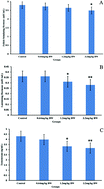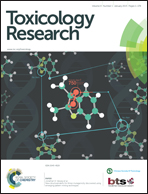Subchronic cyanide toxicity on male reproductive system of albino rat
Abstract
Sexually mature albino rats were orally treated with sodium cyanide, NaCN (0, 0.64, 1.2 and 3.2 mg kg−1 BW) for 90 days. After 90 days of treatment, the rats were euthanized and male reproductive functions were assessed by histopathology, sperm head counts, sperm motility, sperm morphology and hormonal assay. Only a higher dose (3.2 mg kg−1 BW) of NaCN caused significant changes in body and reproductive organs weight, sperm motility, sperm count, sperm abnormality and in the levels of luteinizing hormone (LH), follicular stimulating hormone (FSH) and testosterone, whereas the group treated with 1.2 mg kg−1 BW showed significant changes in testis and prostate weight, sperm motility, sperm count, LH and testosterone levels. In contrast, insignificant changes were observed in body weight gain, reproductive organs weight, sperm parameters and hormonal levels in the rats treated with the lowest (0.64 mg kg−1 BW) dose of NaCN. Histopathologically, NaCN caused atrophy, degeneration in testis, increased number of clearing cells, vacuolation in epididymis and decreased secretion, and desquamations of glandular epithelium in the prostate were observed only at higher (1.2 and 3.2 mg kg−1 BW) dose levels compared to control. Whereas no changes in histology were observed in the rats treated with 0.64 mg kg−1 BW. Our results suggest that a high (3.2 mg kg−1 BW) dose of NaCN can exert reproductive toxicity in male Wistar albino rats.


 Please wait while we load your content...
Please wait while we load your content...